Saturday, November 08, 2003
Æ sestertius, Göbl MIR 36, 15dd
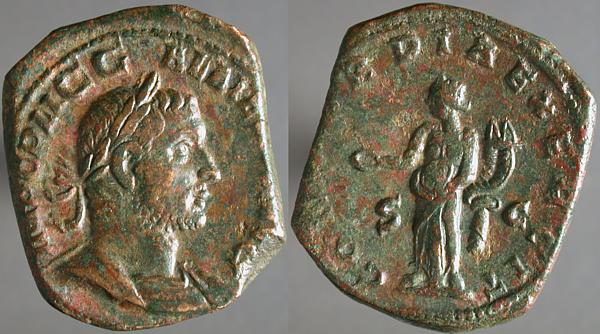
Gallienus sesterius. IMP C P LIC GALLIENVS AVG, Laureate cuirassed bust right, both ribbons behind / CONCORDIA EXERCIT, Concordia standing facing, head left, holding patera left and double cornucopias right. S_C across fields.
As early as Marcus Aurelius (reigned 161-180) sestertii with these squared-off shapes begin to be seen, and by the time of Valerian and Gallienus it's rare to see anything else.
Presumably this allowed a larger number of planchets to be prepared in a shorter amount of time. Why this was true only for sestertii isn't clear, but the other denominations are not typically seen like this. The sestertius, as, and denarius did not continue to be produced as regular circulating coins after this reign although the denarius was produced, perhaps for ritual use, sporadically through the reign of Aurelian (270-275.)
Friday, November 07, 2003
Billon antoninianus, Göbl MIR 36, 939z

Antoninianus SAL VALERIANVS CS, Radiate draped bust right / PRINC IVVENT, Saloninus standing facing in military garb, head left, holding short scepter left and transverse reversed spear. One standard right.
Saloninus, elder son of Gallienus & Salonina was raised to the office of Caesar after his brother's death circa 258 CE. This coin, minted at Mediolanum (now Milan,) announces his position as leader of the youth, a common epithet for a young Caesar. In Germany in 260, while Gallienus led his troops, the general Postumus, responsible for Saloninus's safety, rebelled against Gallienus, killed his son, and formed the break-away "Gallo-Roman Empire", which lasted until Tetricus and his like-named son surrendered to Aurelian in 273.
Thursday, November 06, 2003
Æ31, Perinthus in Thrace, BMC 31
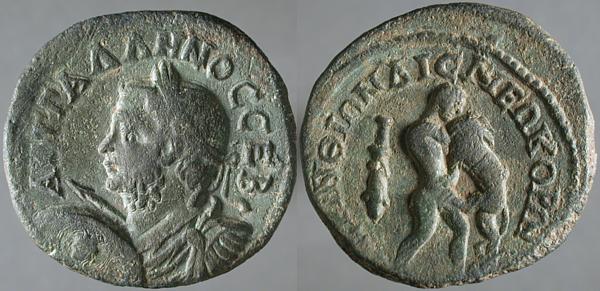
Æ31 Gallienus, Perinthus in Thrace ΑVΤ ΓΑΛΛΗΝΟC CΕΒ, Laureate draped cuirassed bust left, with spear and shield / ΠΕΡΙΝΘΙΩΝ ΔΙC ΝΕΩΚΟΡΩΝ, Herakles, left, strangling Nemean lion. Club in left field.
The obverse portrays Gallienus in military garb, cuirassed, bearing shield and spear. No idle boast, Gallienus successfully defended the empire against invading German tribes and presided over great refinements in the ability to rapidly deploy Roman cavalry.
The reverse legend names Perinthus as the site of two Neokorate temples, sources of civic pride, they hosted a cult of the Imperial family. The cult was not practiced at Rome itself, but was wide-spread in the Greek-speaking East, used to living gods since Hellenistic times, if not even earlier.
Wednesday, November 05, 2003
Billon Tetradrachm, Commodus, Alexandria, Emmett 2542(29), 188-189 CE
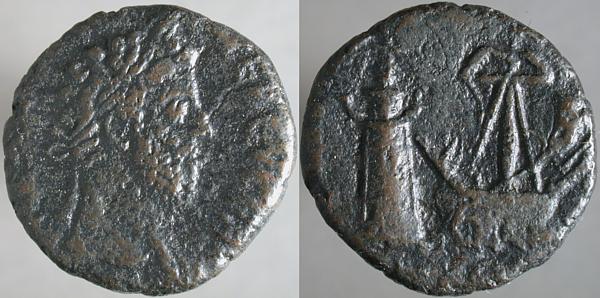
Commodus, son of Marcus Aurelius, reigned from his father's death of an uncertain illness in 180 CE until he was assassinated in his bath in 192 CE. While Aurelius is renowned as one of Rome's greatest emperors, Commodus is still viewed as one of the worst.
The reverse shows a ship sailing before the Pharos, the great lighthouse at Alexandria, one of the seven wonders of the ancient world.
The Pharos was, of course, still operating and visible every day to the inhabitants of Alexandria when this coin was minted there, over 1800 years ago.
Tuesday, November 04, 2003
Billon antoninianus, Göbl MIR 36, 1691p
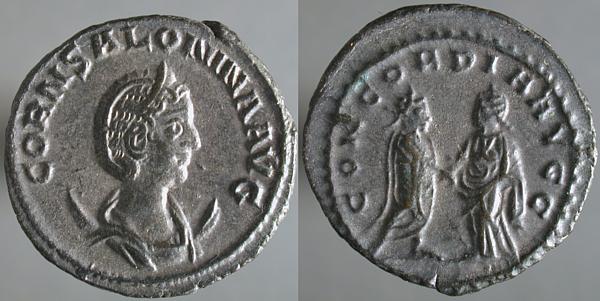
Antoninianus to the concord of the Augusti. CORN SALONINA AVG, Diademed draped bust right on crescent / CONCORDIA AVGG, Gallienus left facing Salonina right, holding hands. Minted at Samosata, now beneath the waters behind the Ataturk Dam.
CONCORDIA type coins, often showing just a Roman, open-thumbed, handshake seem to be issued when there is no concord: CONCORDIA EXERCITVVM for Nerva as the army lost confidence in Nerva, CONCORDIA AVGG for Balbinus, when Balbinus and Pupienus had daggers out for each other, a CONCORDIA type for Pupienus with the legend PATRES SENATVS when the fathers of the senate shared Balbinus's disdain for his colleague.
Whether a coin celebrating the concord of the imperial marriage should be seen, then, as indication that all was not well is probably unanswerable. Imagining it having been issued while Gallienus recovered from a black eye, or two, suffered when Salonina and Pipa first met, while quite insupportable, is an amusing collector's conceit.
Monday, November 03, 2003
Æ28, Heliopolis in Coele-Syria, SNG Cop 438var
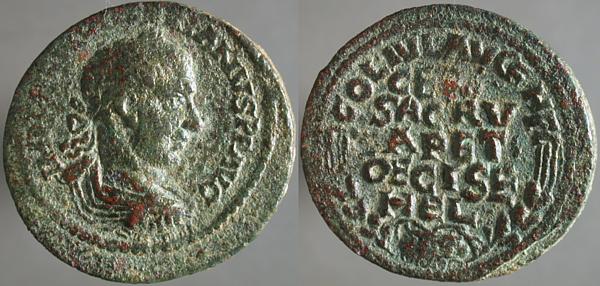
Æ28, Valerian, Heliopolis in Coele-Syria. IMP C[AES P LIC VAL]ERIANVS AVG, laureate draped cuirassed bust right / COL IVL AVG F HEL, CER[T] / SACRV / [C]APET / OEC ISE / HEL in five lines, prize urn beneath, palms protruding, grain ears around.
In a Harlan J. Berk auction of another coin with similar reverse inscription, it was explained as "The sacred Capitoline ecumenical iselastical games held at Heliopolis" (now Baalbek Lebanon)
Games and prizes for games were the subject of many coins of Heliopolis at this time. These games would have included various athletic competition, may have included literary competition, and probably would have featured gladiatorial combat.
Valerian, father of Gallienus, came to a bad end. No friend of the Christians, his misfortune is still viewed in certain circles as rather just deserts.
Some early photographs of Baalbek by Félix Bonfils.
Sunday, November 02, 2003
Billon antoninianus, Göbl MIR 36, 979r
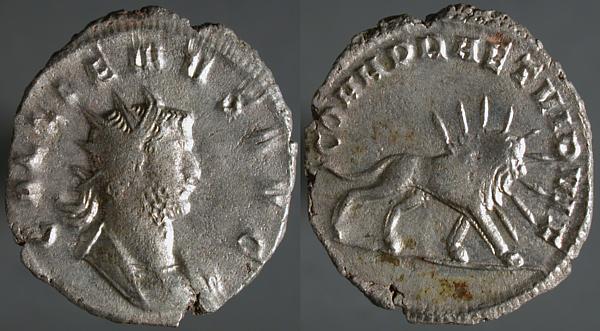
Legionary series antoninianus. GALLIENVS AVG, Radiate cuirassed bust right / COHH PRAET VI P VI F, Radiate lion walking right.
The Praetorian cohorts began under Caesar Augustus as the Imperial bodyguard, and continued to be an elite force, serving a shorter term of service at higher pay rate of pay than the regular army, and receiving special donatives on the accession of a new emperor (who was well advised to secure their loyalty.) They were finally disbanded under Constantine.
Gallienus issued three nearly identical series of coins for the legions and the Praetorians, differentiated by the numbering of Piety and Fidelity in the reverse legend. V P V F is understood to recognize the victory over the the Alemanni, VI P VI F (by far the most common of these coins) victory over the usurper Ingenuus, and VII P VII F victory over the usurper Regalianus. Some legions are not honored on all three series.
Minted at Mediolanum, the coins are a fascinating series. Unlike the earlier legionary denarii of Mark Antony and Septimus Severus, the Gallienus coins feature the various symbols of the legions being honored. It's not unreasonable to suspect that many of them were initially issued in donatives to those same legions.

